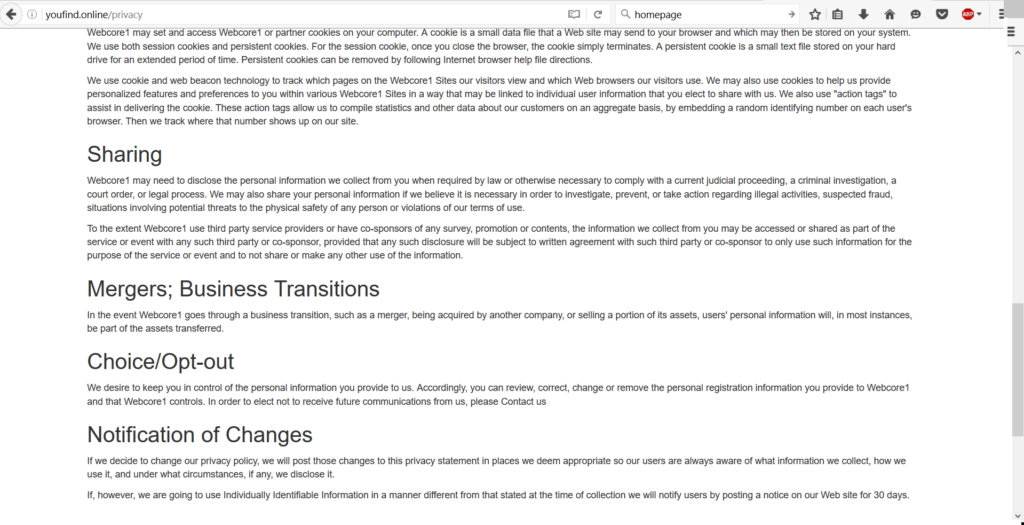Youfind.online is the homepage of a browser hijacking malware. It’s a fake search engine, generating excessive ads, redirects and shows misleading results. If Youfind(.)online has infected your system, you can remove it using the information provided in the article bellow. Your browsers will have their homepage, new tab and the search engine changed. Sponsored adverts may appear in your search results.
| Name |
|
| Main Domain Address |
Youfind.online |
| Solution #1 |
The easiest way to remove and other browser hijackers from your computer is with the help of an anti-malware tool. This software will also protect your computer from severe cyber threats like ransomware |
|
Solution #2 |
You can remove the browser hijacker by hand by carefully following all the guidelines of our step-by-step guide below. |
| Distribution |
PUPs, malicious ads, bundle packs. |
Youfind.online – Details
Main page of the Youfind(.)onine browser hijacker

This is how the main page of the browser hijacker looks like. Your homepage would be changed to Youfind.online if your browser gets hijacked. Your browsers settings and default search engine would also be changed. That can happen through extensions. Another reason why the browser hijacker is bad for your computing is it slows down your system, as it’s still a process that needs to be run. That’s putting a needless strain on your PC’s performance.
Youfind.online’s Privacy Policy

Youfind.online’s Privacy Policy is short and obscure. The site admits that personal information of their users will not be protected and would be passed on to third parties.
Browser hijackers collect:
• Personal data of your searches on their site
• Browsing history
• Downloads
• Many other types of personal data.
Just by using their malicious search engine, you’re granting them permission to collect your personal data, which will be sold to whoever’s buying. If Youfind(.)online has hijacked your browser, you should remove it ASAP.
Youfind.online – Distribution
Youfind.online is usually found in third-party installer setups. If you’re not careful, you can install it without knowing because the installation settings have hidden options. These options are in the Custom and Advanced parts of the installation window. When installing a program, make sure to deselect any bundled applications you don’t want on your PC.
Other ways of distributing Youfind.online is through online ads and banners. Don’t click on Web ads featured in shady unreliable sites. Browsers that can be affected by Youfind.online are Google Chrome, Mozilla Firefox, Internet Explorer/ Microsoft Edge and others.
Removing Youfind.online
You can remove the Youfind(.)online browser hijacker by following the tutorial bellow. Be sure to completely remove the malware with all of its components (all files, extensions, and changed settings.) That way you can be sure that harmful files won’t linger in your system and cause more problems.
How to Enter Safe Mode
Booting Into Safe Mode in the Windows XP, Vista, 7 operating systems
- Unplug devices such as USB flash drives, Memory Sticks, DVD’s, CD’s, anything that can be bootable
- Now you have to decide which of the following methods is right for your computer. If you have:
- –One operating system on your PC, then press F8 repeatedly when you see the first boot screen after restarting your computer. If the Windows logo appears, repeat the same action until you enter the
–Multiple operating systems on your computer. This is very similar to booting with a single operating system. Press F8 repeatedly when you see the first boot screen. You just have to use the arrow keys to choose which system you should boot. - When the Advanced Boot Options appear, you should select the Safe Mode option with the arrow keys. Confirm the selection by pressing Enter
- Log into your computer using the Administrator account
While you’re in safe mode, your screen will be windowed.
Booting into Safe Mode on the Windows 8, 8.1, and 10 Operating Systems
- Open the Start menu
- Hold down the Shift button and left-click on the Power icon, then click Restart
- After the reboot, the Startup menu will appear. From there, choose Troubleshoot
- From the Troubleshoot menu choose Advanced Options
- Once you’re in Advanced Options, click on Startup Settings
- Click Restart
- A menu should appear after the reboot. Choose Safe Mode by pressing its corresponding key number. The PC will restart and boot into Safe Mode.
Remove/Uninstall Youfind.online from Windows
Here’s a way to remove the program. This method will work regardless if you’re on Windows 10, 8, 7, Vista or XP. Simply selecting the program and pressing delete won’t work, as it’ll leave a lot of small files. That’s bad because these leftovers can linger on and cause all sorts of problems. The best way to delete a program is to Uninstall it. Here’s how you can do that:
- Hold the “Windows” button (It’s between CTRL and Alt on most keyboards) and press “R.” You’ll see a pop-up window
- In the textbox, type “appwiz.cpl”, then press “Enter.”
- The “Programs and features” menu should now appear. It’s a list of all the programs installed on the PC. Here you can find the program, select it, and press Uninstall.
Follow these instructions and you’ll be able to uninstall it successfully.
How to Remove Youfind.online from Your Browser
Before resetting your browser’s settings, you should know that this action will wipe out all your recorded usernames, passwords, and other types of data. Make sure to save them in some way
Internet Explorer
- Start Internet Explorer
- Go to the Tools menu and click on Manage add-ons.
- In the Manage add-ons window, bellow Add-on Types, select Toolbars and Extensions
- If you see a suspicious toolbar, select it and click Disable
- In Manage Add-ons window, in Add-on Types, Select Search Providers
- Chose a search engine and click Set as default
- Select the unknown search engine and click Remove and Close
- Open the Tools menu, select Internet Options
- In the General tab, in Home page, enter your preferred page
- Click Apply and OK
- On the desktop, right-click on Internet Explorer icon and select Properties
- In the Properties window, under the Shortcut tab, in Target delete the text after iexplore.exe
- Click Apply, click OK to save
- Click Close
- Start Google Chrome
- On the upper-right corner, there a Customize and Control Google Chrome menu icon. Click on it, then click on Settings
- Click Extension under Chrome
- In the Extensions menu, click on the unknown extensions, then click on the trash bin icon
- Under Chrome, Click on Settings
- In Settings, under on Startup click Set pages
- In the Startup pages menu, select the suspicious entries and click on X
- Click OK
- In Settings, under Appearance select the Show home button and click Change
- In the Home page menu, click Use New Tab page and press OK
- In the Settings window under Search, click on Manage search engines
- Once you enter Search engines, select your search engine of choice and click Make default
- In the default search settings list, find the unknown search engine and click on X
- Click Done
- Start Mozilla Firefox
- In the upper right corner, click on the Open menu icon and select Add-ons
- Inside the Add-ons Manager select Extensions
- Search the list of extensions for suspicious entries. If you find any, select them and click Disable
- Click on the Open menu icon, then click Options
- In the Options window, under General tab, Click Restore to Default
- Click OK
- In the Firefox window, right next to the URL field, click the down arrow icon. Select Manage Search Engines
- In Manage Search Engines List window, select the unknown search engine and press Remove
- Click OK



